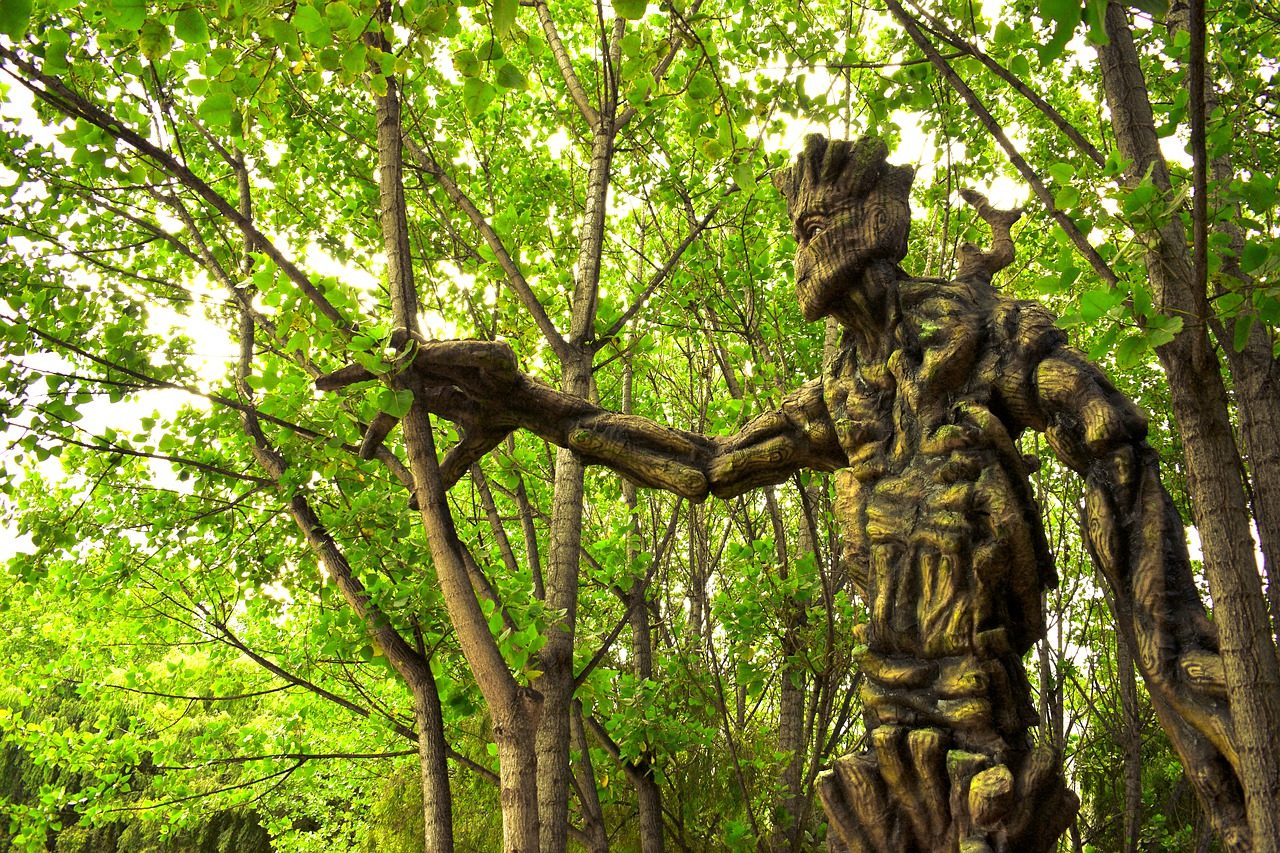To a Creation, Clothes
In my last post, we began with a story of creation on a windswept beach. But today, we’ll begin by following in the footsteps of a wandering god to a field.
The god in question is the same as the giver of önd in our first story. He is Óðinn, a god of many names, the one who I call “Old Man”. This time though, it’s not trees he encounters, but two “tree-men”. And there is no giving of önd, óðr, or lá and litr here. This time, the Old Man simply gives them clothes (Hávamál 49).
This always reminds me of a story written by the twelfth century poet, Marie 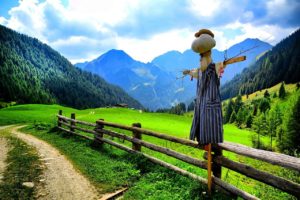 de France. In one of her lais, Bisclavret, a man-turned-werewolf is prevented from returning to his shape of birth by an unfaithful lover hiding his clothes. You see, when it comes to masking and its sibling, shapeshifting, there always seems to be an element of dressing for the “job” you want. The person who wishes to become a wolf must do as Sigmund and Sinfjotli did in the Saga of the Volsungs and don the skin of a wolf. And perhaps the tree that is to become a person, must wear a person’s clothes.
de France. In one of her lais, Bisclavret, a man-turned-werewolf is prevented from returning to his shape of birth by an unfaithful lover hiding his clothes. You see, when it comes to masking and its sibling, shapeshifting, there always seems to be an element of dressing for the “job” you want. The person who wishes to become a wolf must do as Sigmund and Sinfjotli did in the Saga of the Volsungs and don the skin of a wolf. And perhaps the tree that is to become a person, must wear a person’s clothes.
So, we have two sets of trees being made people when encountering a certain One-Eyed God. One might call that an M.O.
But what does that have to do with us and the magic we might create?
Mythological Fix Points and Magic
Some of you may have already heard of Mircea Eliade, the Romanian historian of religion who openly supported the Romanian fascist organization, The Iron Guard. He is a problematic figure, for sure. But when it comes to working with historical forms of magic, I have found some of his work to be quite useful. You see, for Eliade, every significant human activity (as well as acts of creation and foundation) had a mythological “fix point”. They are rooted in myth and we are acting in pale imitation of what the gods are depicted as doing in mythological time.
Eliade can’t really take the credit for this concept though. The idea that humans imitate the gods is quite ancient. There are texts in the Yajurveda (a veda which concerns ritual practice), that specifically mention this concept. In the Satapatha Brahmana, the reader (presumably a budding ritualist) is instructed to ”do what the Gods did in the beginning” (VII, 2, 1, 4). And the Taittiriya Brahmana further underlines the importance of this idea with the following statement: “Thus the Gods did; thus men do” (I, 5, 9, 4).
Woden Worhte Weos: Animation as Woden’s Magic
So we have a god with an MO of making people out of trees. Some would even say that this is a kind of magic specific to that god (Richard North, I’m looking at you).
There’s a curious passage in the Old English Maxims that is worth a look here.
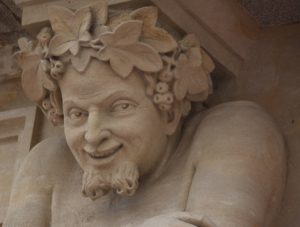 ”Woden worhte weos, wuldor alwalda,
”Woden worhte weos, wuldor alwalda,
rume roderas: þæt is rice god
sylf soðcyning, sawla nergend”
(Maxims I, II, 132 – 34)
(Woden made idols, the almighty [made] glory,
the roomy heavens; this is a powerful god
himself the true king, healer of souls.)
As scholars have pointed out, this passage is clearly modeled on a line from Jerome’s Psalter iuxta Hebraeos. Maxims I isn’t the only place we find echoes of this line either. And curiously, in some of those other texts that contain reflections of this line, the “idols” are described as “demons”, suggesting that the idols themselves are more than carved wood. This idea of ‘living’ idols is made clearer in Saxo’s Gesta Danorum. In the Gesta, Óðinn (here, Othinus) is shown restoring a desecrated statue of himself, and ”by amazing craftsmanship made it respond with a voice to human touch” (Richard North, Heathen Gods in Old English Literature, pp 88 – 90).
There’s a lot to unpack here – the idea of ‘living’ idols is probably quite a bombshell for a lot of modern Heathens. But that’s not the focus of this post – creation is. And once again, we see the Old Man associated with the act of creation.
But if the sentiment found in the the Yajurveda and advanced as a theory by Eliade is true, then we should expect to find some human imitation of this form of magic, right?
Tree-Men
In the Hávamál passage mentioned earlier, Óðinn encounters two tree-men (‘trémönnom’ in ON). But this is not the only example of trémaðr (the singular form of ‘trémönnom’) in the ON corpus.
There are a number of mentions of tree-men, but two in particular stand out for the details they provide. In the Flateyjarbok, a group of men put ashore on 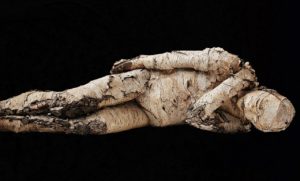 the island of Sámsey. There they encounter a ‘tree-man’ who speaks to them of his purpose and origin. He was the product of sacrifice, and had been made to bring about the deaths of men in the southern part of Sámsey. But over the years, he’d become overgrown and his clothes and flesh rotted away.
the island of Sámsey. There they encounter a ‘tree-man’ who speaks to them of his purpose and origin. He was the product of sacrifice, and had been made to bring about the deaths of men in the southern part of Sámsey. But over the years, he’d become overgrown and his clothes and flesh rotted away.
(Those of you who are well read in the ON corpus will probably recognize Sámsey as the island where Loki claimed that Óðinn worked seiðr.)
The second example is in Þorleifs þáttr Jarlsskálds. In this story, Hákon Jarl creates a trémaðr to kill Þorleif Jarlsskáld after Þorleif cursed him with ‘itching sickness’.
Despite the connection between Óðinn and tree-men though, it was to the sisters, Þorgerðr Hörgi’s bride and her sister Irpa – a somewhat mysterious duo of goddesses that feature in a few sagas – that Hákon Jarl made his sacrifices. The process is outlined quite well for us here. First, Hákon Jarl  makes the sacrifices until he receives a favorable oracle when he has a piece of driftwood brought in and fashioned into the shape of a wooden man. Then with “the monstrous witchcraft and python’s breath” of those two sisters, as well as the heart of a man sacrificed for the purpose and the proper attire for a man, they sent their tree-man, now named Þorgarðr, into the world to kill Þorleif (North 93 – 95).
makes the sacrifices until he receives a favorable oracle when he has a piece of driftwood brought in and fashioned into the shape of a wooden man. Then with “the monstrous witchcraft and python’s breath” of those two sisters, as well as the heart of a man sacrificed for the purpose and the proper attire for a man, they sent their tree-man, now named Þorgarðr, into the world to kill Þorleif (North 93 – 95).
But Óðinn’s hands are perhaps not entirely absent from this story. Because after Þorgarðr kills Þorleif (disappearing into the ground once his mission is complete), Þorleif’s dying words mention one of Óðinn’s kennings, Gautr in relation to the tree-man (North 95-96).
Creation: The Bare Ingredients
The parallels between Askr and Embla, and Þorgarðr are quite clear. And more importantly, provide us with a bridge between the mythological and the sagaic. Or in other words: the realm of gods and realm of men.
In both stories of creation, the creator begins with driftwood and imbues the creation with breath, color and vital blood/warmth, and mind/purpose. In the mythological story these are attributes that are magically given. But in the sagaic, the önd remains the domain of deities (at least for Hákon); the blood and heart from the sacrificed man provide the lá and litr; and the incantations/empowerment, the óðr.
Adaptation
So now we have the bare ingredients for creation. Now I’m not suggesting that people begin creating tree-men (assuming that’s even magically possible at this time given the current dominant paradigm). But in my experience, this process of creation is useful for everything from the creation of magical tools, to poppets and magical cures.
This process does require some adaptation though. I most certainly do not advise that any of us engage in human sacrifice as it’s illegal and wrong. Moreover, we’re not trying to animate whole men, so in terms of scale, it’s
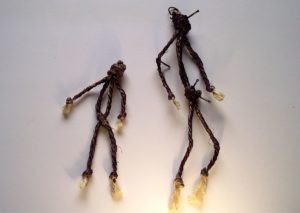
probably not even necessary either.
When I create magically, I follow the order of creation in the myth of Askr and Embla, and begin with my breath. For those of you who engage in possessory work, sessions in which you are carrying the Old Man would be the perfect time to engage in magical creation (with his agreement, of course). For those of you who don’t, you can take a leaf out of the migration period warlord’s playbook and simply ritually assume the role of Óðinn while you work. Remember that dressing for the job you want is a thing – yes, even with this.
Then comes the lá and litr. For me, this heat/blood can be either my own blood, or water and passing over a candle flame. Color can come from sigils, markings, or simply a coat of paint. Depending on what you’re doing, you may or may not wish to use your own blood (and if you do, be safe and sterile about it).
The final step is incantation, which I take to be the giving of óðr to your creation. This is often tied in with the giving of breath/önd in more practical terms. And in my opinion, this was probably the case historically too – at least when it came to herbal infusions and salves. The Old English magico-medical manuscripts give the instruction to “let the breath go wholly in” while chanting galdor. I do not think this to be coincidental.
Depending on what you are creating, you may wish to also give your creation a name. There is a long tradition of named objects in the North, as well as objects with a sense of agency and ‘fate’.
But whatever you create, you must always create carefully. Because this kind of magical creation isn’t just some arts and crafts project to use in a LARP. You are creating, and you will always have some degree of responsibility for (and to) what you create. You may wish to also bear this in mind when you’re writing your wills.
In the next post, I’m going to be talking about how I approach the elements in my magical practice. But until then, be well.

